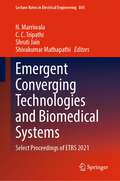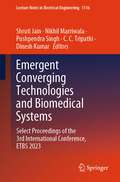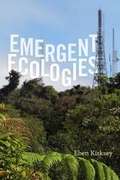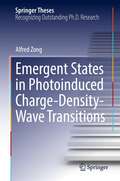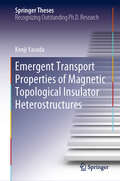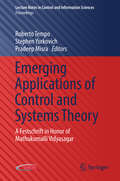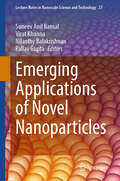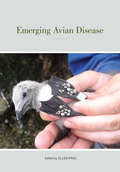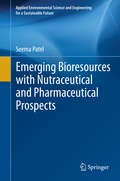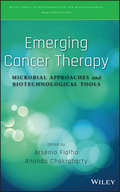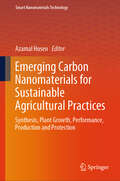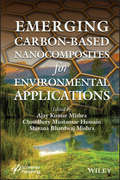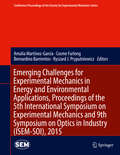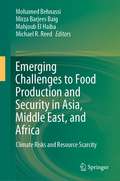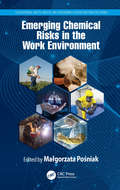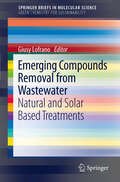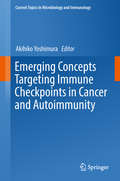- Table View
- List View
Emergent Converging Technologies and Biomedical Systems: Select Proceedings of ETBS 2021 (Lecture Notes in Electrical Engineering #841)
by Shruti Jain C. C. Tripathi Shivakumar Mathapathi N. MarriwalaThe book contains peer-reviewed proceedings of the International Conference on Emergent Converging Technologies and Biomedical Systems 2021. It includes papers on wireless multimedia networks, green wireless networks, electric vehicles, biomedical signal processing and instrumentation, wearable sensors for health care monitoring, biomedical imaging, & bio-materials, modeling and simulation in medicine biomedical and health informatics. The book will serve as a useful guide for educators, researchers, and developers working in the area of signal processing, imaging, computing, instrumentation, artificial intelligence, and their related applications. This book will also provide support and aid to the researchers involved in designing the latest advancements in healthcare technologies.
Emergent Converging Technologies and Biomedical Systems: Select Proceedings of the 2nd International Conference, ETBS 2022 (Lecture Notes in Electrical Engineering #1040)
by Dinesh Kumar Shruti Jain Nikhil Marriwala C. C. TripathiThe book contains proceedings of the International Conference on Emergent Converging Technologies and Biomedical Systems ETBS 2022. It includes papers on wireless multimedia networks, green wireless networks, electric vehicles, biomedical signal processing and instrumentation, wearable sensors for health care monitoring, biomedical imaging, & bio-materials, modeling and simulation in medicine biomedical, and health informatics. The book will serve as a useful guide for educators, researchers, and developers working in the area of signal processing, imaging, computing, instrumentation, artificial intelligence, and their related applications. This book will also provide support and aid to the researchers involved in designing the latest advancements in healthcare technologies.
Emergent Converging Technologies and Biomedical Systems: Select Proceedings of the 3rd International Conference, ETBS 2023 (Lecture Notes in Electrical Engineering #1116)
by Dinesh Kumar Shruti Jain Nikhil Marriwala C. C. Tripathi Pushpendra SinghThe book contains proceedings of the International Conference on Emergent Converging Technologies and Biomedical Systems ETBS 2023. It includes papers on wireless multimedia networks, green wireless networks, electric vehicles, biomedical signal processing, and instrumentation, wearable sensors for health care monitoring, biomedical imaging, and bio-materials, modeling, and simulation in medicine biomedical, and health informatics. The book serves as a useful guide for educators, researchers, and developers working in the areas of signal processing, imaging, computing, instrumentation, artificial intelligence, and their related applications. This book also provides support and aid to the researchers involved in designing the latest advancements in healthcare technologies.
Emergent Ecologies
by Eben KirkseyIn an era of global warming, natural disasters, endangered species, and devastating pollution, contemporary writing on the environment largely focuses on doomsday scenarios. Eben Kirksey suggests we reject such apocalyptic thinking and instead find possibilities in the wreckage of ongoing disasters, as symbiotic associations of opportunistic plants, animals, and microbes are flourishing in unexpected places. Emergent Ecologies uses artwork and contemporary philosophy to illustrate hopeful opportunities and reframe key problems in conservation biology such as invasive species, extinction, environmental management, and reforestation. Following the flight of capital and nomadic forms of life--through fragmented landscapes of Panama, Costa Rica, and the United States--Kirksey explores how chance encounters, historical accidents, and parasitic invasions have shaped present and future multispecies communities. New generations of thinkers and tinkerers are learning how to care for emergent ecological assemblages--involving frogs, fungal pathogens, ants, monkeys, people, and plants--by seeding them, nurturing them, protecting them, and ultimately letting go.
Emergent Nested Systems
by Christian WallothThis book presents atheory as well as methods to understand and to purposively influence complexsystems. It suggests a theory of complex systems as nested systems, i. e. systems that enclose other systems and that are simultaneously enclosed by evenother systems. According to the theory presented, each enclosing system emergesthrough time from the generative activities of the systems they enclose. Systems are nestedand often emerge unplanned, and every system of high dynamics is enclosed by asystem of slower dynamics. An understanding of systems with faster dynamics,which are always guided by systems of slower dynamics, opens up not only newways to understanding systems, but also to effectively influence them. The aim and subjectof this book is to lay out these thoughts and explain their relevance to thepurposive development of complex systems, which are exemplified in case studies from an urban system. Theinterested reader, who is not required to be familiar with system-theoreticalconcepts or with theories of emergence, will be guided through the developmentof a theory of emergent nested systems. The reader will also learn about newways to influence the course of events - even though the course of events is,in principle, unpredictable, due to the ever-new emergence of real novelty.
Emergent Science: Teaching science from birth to 8
by Jane JohnstonEmergent Science is essential reading for anyone involved in supporting scientific learning and development with young children aged between birth and 8. Drawing on theory, the book helps to develop the essential skills needed to understand and support science in this age range. The book is organised into three parts: development, contexts and pedagogy, exploring the underpinning theory alongside practical ideas to help trainees, teachers and childcare practitioners to create high-quality science experiences for the children they teach. The text includes guidance on developing professional, study and research skills to graduate and postgraduate level, as well as all the information needed to develop scientific skills, attitudes, understanding and language through concrete, social experiences for young children. Features include: Reflective tasks-at three levels of professional development;- early career/student, developing career/teacher and later career/leader. Case studies that exemplify good practice and practical ideas. Tools for learning - explain how science professionals can develop their professional, study skills and research skills to Masters level
Emergent States in Photoinduced Charge-Density-Wave Transitions (Springer Theses)
by Alfred ZongThis book advances understanding of light-induced phase transitions and nonequilibrium orders that occur in a broken-symmetry system. Upon excitation with an intense laser pulse, materials can undergo a nonthermal transition through pathways different from those in equilibrium. The mechanism underlying these photoinduced phase transitions has long been researched, but many details in this ultrafast, non-adiabatic regime still remain to be clarified. The work in this book reveals new insights into this phenomena via investigation of photoinduced melting and recovery of charge density waves (CDWs). Using several time-resolved diffraction and spectroscopic techniques, the author shows that the light-induced melting of a CDW is characterized by dynamical slowing-down, while the restoration of the symmetry-breaking order features two distinct timescales: A fast recovery of the CDW amplitude is followed by a slower re-establishment of phase coherence, the latter of which is dictated by the presence of topological defects in the CDW. Furthermore, after the suppression of the original CDW by photoexcitation, a different, competing CDW transiently emerges, illustrating how a hidden order in equilibrium can be unleashed by a laser pulse. These insights into CDW systems may be carried over to other broken-symmetry states, such as superconductivity and magnetic ordering, bringing us one step closer towards manipulating phases of matter using a laser pulse.
Emergent Transport Properties of Magnetic Topological Insulator Heterostructures (Springer Theses)
by Kenji YasudaThis book reveals unique transport phenomena and functionalities in topological insulators coupled with magnetism and superconductivity. Topological insulators are a recently discovered class of materials that possess a spin-momentum-locked surface state. Their exotic spin texture makes them an exciting platform for investigating emergent phenomena, especially when coupled with magnetism or superconductivity. Focusing on the strong correlation between electricity and magnetism in magnetic topological insulators, the author presents original findings on current-direction-dependent nonreciprocal resistance, current-induced magnetization reversal and chiral edge conduction at the domain wall. In addition, he demonstrates how the coupling between superconductivity and topological surface state leads to substantial nonreciprocal resistance. The author also elucidates the origins of these phenomena and deepens readers’ understanding of the topologically nontrivial electronic state. The book includes several works which are published in top journals and were selected for the President’s Award by the University of Tokyo and for the Ikushi Prize, awarded to distinguished Ph.D. students in Japan.
Emerging Anti-Aging Strategies
by Syed Ibrahim RizviThe book focuses on the emerging anti-aging approaches for maintaining better health in old age. It provides a current understanding of the underlying principle, possible targets, implementation approaches, and efficacy of the various anti-aging strategies. The chapters include a wide range of topics incorporating the major advances in anti-aging strategies, including telomerase activation, stem cell therapy, autophagy induction, sirtuin activation, and dietary restrictions. Further, it discusses the epigenetic mechanisms underlying aging-related processes and epigenetic strategies to delay and reverse aging-related diseases. The book covers the strategy based on tissue engineering and regenerative medicine for understanding the complexity of aging and restoring the functionalities of organ systems. It further presents the applications of melatonin supplementation-based anti-aging therapeutic intervention. Finally, the book reviews the ethical dimension of anti-aging intervention strategies. This book is immensely useful to scientists and researchers from various disciplines in the life sciences.
Emerging Applications of 3D Printing During CoVID 19 Pandemic (Lecture Notes in Bioengineering)
by Neeta Raj Sharma Chander Prakash Sunpreet Singh Karupppasamy Subburaj Kamalpreet SandhuThis book presents various practical breakthroughs of 3D printing (3DP) technologies in developing different types of tool and gadgets to be used against COVID-19 pandemic. It presents multidisciplinary aspects of 3DP technology in social, medical, administration, and scientific areas. This book presents state-of-the-art applications of 3DP technology in the development of PPE, ventilators, respiratory equipments, and customized drugs. It provides a comprehensive collection of the technical notes, research designs, literature prospective, and clinical applications of 3DP technologies to effectively deal with the COVID-19 pandemic. This book will be beneficial for the medical professionals, pharmacists, manufacturing enterprises, and young scholars in understanding the real potential of 3DP technologies in aiding humans-based activities against the COVID-19 crisis. Having interdisciplinary applications in applied science, this book will also be useful for wide range of academicians, research scholars and industry stakeholders.
Emerging Applications of Control and Systems Theory: A Festschrift In Honor Of Mathukumalli Vidyasagar (Lecture Notes In Control And Information Sciences - Proceedings Ser.)
by Roberto Tempo Stephen Yurkovich Pradeep MisraThis book celebrates Professor Mathukumalli Vidyasagar’s outstanding achievements in systems, control, robotics, statistical learning, computational biology, and allied areas. The contributions in the book summarize the content of invited lectures given at the workshop “Emerging Applications of Control and Systems Theory” (EACST17) held at the University of Texas at Dallas in late September 2017 in honor of Professor Vidyasagar’s seventieth birthday. These contributions are the work of twenty-eight distinguished speakers from eight countries and are related to Professor Vidyasagar’s areas of research. This Festschrift volume will remain as a permanent scientific record of this event.
Emerging Applications of Novel Nanoparticles (Lecture Notes in Nanoscale Science and Technology #37)
by Pallav Gupta Suneev Anil Bansal Virat Khanna Nilanthy BalakrishnanThis book is a comprehensive and modern guide on emerging nanoparticles and their diverse applications in engineering, medicine, food safety, transportation, energy, agriculture, and environmental sustainability. Written by leading researchers from all over the world, it is designed to cover the full range of nanoparticles as well as provide in-depth detail regarding their development, characterization, processing, and synthesis. The book is divided into two sections: the first covers the development of advanced nanoparticles and the second is dedicated to their variety of cutting-edge applications. The authors also cover the unique properties and green synthesis of nanoparticles as well as their use as nanobiosensors, nanopesticide, nanofertilizer, and as energy storage and conversion devices, just to name a few. This book provides readers with insight onto the broad scope of computational, theoretical, and experimental research on novel nanoparticles and their applications. It is ideal for both young and experienced researchers and industry professionals in the field of nanotechnology.
Emerging Areas in Bioengineering
by Jens Nielsen Gregory Stephanopoulos Sang Yup Lee Ho Nam ChangWith more than 40 contributions from expert authors, this is an extensive overview of all important research topics in the field of bioengineering, including metabolic engineering, biotransformations and biomedical applications. Alongside several chapters dealing with biotransformations and biocatalysis, a whole section is devoted to biofuels and the utilization of biomass. Current perspectives on synthetic biology and metabolic engineering approaches are presented, involving such example organisms as Escherichia coli and Corynebacterium glutamicum, while a further section covers topics in biomedical engineering including drug delivery systems and biopharmaceuticals. The book concludes with chapters on computer-aided bioprocess engineering and systems biology. This is a part of the Advanced Biotechnology book series, covering all pertinent aspects of the field with each volume prepared by eminent scientists who are experts on the topic in question. Invaluable reading for biotechnologists and bioengineers, as well as those working in the chemical and pharmaceutical industries.
Emerging Avian Disease
by Ellen PaulIn this volume, new human disease pandemics, arising from animals stimulated by ongoing environmental change, demonstrate the value of ornithological research into avian diseases. A group of 29 researchers addresses a diverse set of topics, including the evolutionary and ecological aspects of the host-vector systems, the effects of genetic variation, introduction success and vector ecology, evolution of resistance and virulence of pathogens, and the effects of changing geographic distributions. In addition to empirical studies under field conditions, the authors present predictive models to assess the movement and potential impact of these diseases. Other chapters delve into the potential impacts of pathogens and the key role of biosurveillance and documenting impacts of disease on bird populations.
Emerging Battery Technologies to Boost the Clean Energy Transition: Cost, Sustainability, and Performance Analysis (The Materials Research Society Series)
by Linda Barelli Stefano Passerini Manuel Baumann Jens F. Peters Marcel WeilThis open access book provides a totally new perspective on the rapidly developing sector of electrochemical energy storage, putting a spotlight on their sustainability under consideration of the latest developments and emerging future technologies. A number of selected, high-level authors from different disciplines discuss the potential contribution of batteries to a cleaner society, the need for new battery concepts, necessary new chemistries and their sustainability. These include not only analyses of the most relevant technological developments in the field, but also the latest state of knowledge in terms of their applicative functionalities in transport and stationary applications within the clean energy transition framework, their potential environmental impacts, resource demands and social impacts, and the corresponding methodological advances. All these aspects are analyzed on micro-level (i.e., for the specific technology), but also on macro-scale i.e., from a systemic perspective, providing a glimpse on how emerging battery systems might cover future energy storage demand. By taking a prospective and interdisciplinary viewpoint, this book will be of interest for a broad field of readers interested in electrochemistry, engineering with particular focus on electric grids and on-board systems and energy system analysis, but also those worried about the sustainability and societal challenges related with the energy transition(s).
Emerging Bioresources with Nutraceutical and Pharmaceutical Prospects
by Seema PatelThis book introduces some emerging functional foods that are natural resources with tremendous promise as nutraceuticals and pharmaceuticals. The author considers biodiversity and bioprospecting as a response to food security issues, drug-resistance, nutrition-poor diets and other problems, exploring the prospects of several under-utilized nutrients and bioactive repositories. Readers will discover biochemical makeups, validated health benefits, explanations of underlying mechanisms, hurdles in the path of popularity and promotion strategies. Chapters explore particular plants, seeds and fruits including the strawberry guava, opuntia fruits, the Carissa genus, grape seeds, quinoa and the milk thistle (Silybum), amongst others. They are considered as food sources where possible and from the perspective of the roles they can play in complementary and alternative medicine, such as in wound healing, antimicrobial activity, gastroprotective activity in treatment of cancers and as natural antioxidant sources. This rich compilation holds plausible solutions to a range of current issues and it endorses the much-needed goal of sustainability in terms of diet and drugs. It paves the path for further research and development on hitherto obscure natural resources. Scientists working in the area of food development, phytochemical and antioxidant analysis, bioprospecting of low-profile foods and in complementary and alternative medicine will find this work particularly valuable. It will also be of interest to the general reader with an interest in food science, food security, phytochemicals and functional food studies.
Emerging Cancer Therapy: Microbial Approaches and Biotechnological Tools (Wiley Series in Biotechnology and Bioengineering #3)
by Ananda Chakrabarty Arsenio FialhoExplores current and emerging applications of microbes as cancer-fighting agents WILEY SERIES IN BIOTECHNOLOGY AND BIOENGINEERING Anurag S. Rathore, Series Editor Today, treatment options for cancer patients typically include surgery, radiation therapy, immunotherapy, and chemotherapy. While these therapies have saved lives and reduced pain and suffering, cancer still takes millions of lives every year around the world. In recent years, researchers have been working on a new strategy: developing microbes and microbial products that specifically attack cancer cells. This book breaks new ground in emerging cancer treatment modalities by presenting recent advances in the use of microorganisms and viruses as well as their products in cancer therapy. Seventeen chapters review the application of live microorganisms, high and low molecular weight products derived from microorganisms, and microbial products fused to cancertargeting molecules. In addition, the book highlights the benefits of a multi-target approach to destroy cancer cells. Readers will not only discover the results and significance of basic and clinical research, but also encouraging results from clinical trials. Emerging Cancer Therapy is divided into three sections: Section 1: Live/Attenuated Bacteria and Viruses as Anticancer Agents Section 2: Bacterial Products as Anticancer Agents Section 3: Patents on Bacteria/Bacterial Products as Anticancer Agents With chapters written by leading pioneers in microbial, biotech, and cancer research, Emerging Cancer Therapy is recommended for biotechnologists, microbiologists, clinical oncologists, medicinal chemists, and biochemists. Readers will not only learn the tremendous potential of microbial and biotechnological approaches to cancer therapy, but also discover new directions of research for effective drug discovery and development.
Emerging Carbon Nanomaterials for Sustainable Agricultural Practices: Synthesis, Plant Growth, Performance, Production and Protection (Smart Nanomaterials Technology)
by Azamal HusenThe potential use of carbon-based nanomaterials in overall plant systems has not yet received much research, and the results that have been reported are typically descriptive and inconsistent with little knowledge of the underlying mechanisms of action. Changes in gene expression and enhanced ROS production are among the physiological processes that may be impacted by interactions with carbon nanomaterials. They penetrate plant cells, are readily taken up by plants, and then influence the key events of plants such as seed germination, seedling growth, root formation, photosynthesis, flowering, yield, and overall performance. Moreover, in terms of soil quality, carbon nanomaterials have the capacity to influence the health status of agricultural soils, and thus, increase sustainable agriculture practices. Currently, plant disease management depends mainly on toxic pesticides that are potentially harmful to humans and the environment. These particles have enabled their use as bactericides, fungicides, and nanofertilizers. Carbon nanomaterials, however, which may be helpful in plant nucleic acid delivery, pesticide and fertilizer application, wastewater treatment, eradication of pathogen-induced plant illnesses, and detection of significant plant molecules, are the subject of this book. The use of carbon nanoparticles in tissue culture medium and plant growth performance has also been examined. The so-called ‘safe-by-design’ strategy for a guided design of nanomaterials without harmful environmental side effects requires knowledge of the special structural properties of particles that determine the deleterious impacts on living beings. Accordingly, the environmental safety, and ethical issues related to the use of carbon nanomaterials in agricultural sectors have been also explored. Overall, the book in hand provides an extensive, important, and selected topic related to carbon nanomaterials in agricultural sectors. This book provides valuable information to scientists, researchers, and students, working especially on agricultural science, plant science, plant pathology, plant biology, plant nanobiotechnology, plant biochemistry, soil microbiology, and other allied subjects.
Emerging Carbon-Based Nanocomposites for Environmental Applications
by Ajay Kumar Mishra Shivani Bhardwaj Mishra Chaudhery Mustansar HussainThe 12 chapters comprehensively cover the development and advances on emerging carbon-based nanocomposites for wastewater applications and discuss the following topics: The emerging carbon-based nanocomposites for remediation of heavy metals and organic pollutants from wastewater; Functional green carbon nanocomposites for heavy-metal treatment in water; Green nanocomposites and their applications in environmentally-friendly carbon nanomaterials; Carbon-based nanocomposites as heterogeneous catalysts for organic reactions in environment-friendly solvents; Carbonaceous nanomaterials for arsenic and chromium removal from waste water; Biochar-based adsorbents for the removal of organic pollutants from aqueous systems; Describes carbon nanomaterials based green nanocomposites; The removal of trihalomethanes from water using nanofiltration membranes and The transformation of wide bandgap semiconductors for visible-light photocatalytic degradation of organic dyes; Nanocomposite materials as electrode materials in microbial fuel cells for the removal of water pollutants; Plasmonic smart nanosensors for the determination of environmental pollutants.
Emerging Challenges for Experimental Mechanics in Energy and Environmental Applications, Proceedings of the 5th International Symposium on Experimental Mechanics and 9th Symposium on Optics in Industry (ISEM-SOI), 2015
by Cosme Furlong Amalia Martínez-García Bernardino Barrientos Ryszard J. PryputniewiczThis book contains papers of the 5th International Symposium on Experimental Mechanics (5-ISEM) and the 9th Symposium on Optics in Industry (9-SOI), whose general theme is Emerging Challenges for Experimental Mechanics in Energy and Environmental Applications. These symposia are organized by Centro de Investigaciones en Optica (CIO) and Mexican Academy for Optics (AMO), under the sponsorship of the Society of Experimental Mechanics (SEM) and other national and international Organizations; Symposia are interdisciplinary forums for engineers, technicians, researchers and managers involved in all fields of Optics, Opto-mechatronics, Mechanics and Mechanical Engineering. #65533; Addresses a broad readership including graduate and postgraduate students, researchers, and engineers working in experimental mechanics and in the application of optical methods #65533; Covers a broad spectrum of topics highlighting the use of optical methods in experimental mechanics, energy, and in the environment
Emerging Challenges to Food Production and Security in Asia, Middle East, and Africa: Climate Risks and Resource Scarcity
by Mohamed Behnassi Mahjoub El Haiba Mirza Barjees Baig Michael R. ReedThis book, as a part of a series of CERES publications, provides a multi-regional and cross-sectoral analysis of food and water security, especially in the era of climate risks, biodiversity loss, pressure on scarce resources, especially land and water, increasing global population, and changing dietary preferences. It includes both conceptual research and empirically-based studies, which provides context-specific analyses and recommendations based on a variety of case studies from Africa, Middle East, and Asia regarding the fostering of long-term resilience of food and water security. The core approach of the volume consists of: assessing the structural drivers affecting the vulnerability of food and water security, under the persistence of current trends; identifying the best solutions and practices to enhance the climate resilience for food and water security; and fostering climate adaptation and biodiversity protection for food and water security.
Emerging Chemical Risks in the Work Environment (Occupational Safety, Health, and Ergonomics)
by Małgorzata PośniakAround the world, the production and use of nanomaterials, as well as carcinogenic, mutagenic, reprotoxic substances (CMR) and endocrine disruptors has systematically increased. The increase in production has exposed workers to hazardous substances in practically all branches of the world economy. Readers will have access to up-to-date and comprehensive knowledge on emerging risks related to nanomaterials, endocrine disruptors, reprotoxic, carcinogenic and mutagenic substances, which are related to the development of technologies and workplaces. The book will provide the tools for occupational risk assessment of chemical substances for which there are no safety levels of exposure as well as an indication of methods and measurements to protect human health and reduce chemical risks at the workplace. This book creates awareness for employers, employees and safety experts about emerging risks related to chemical agents resulting in the reduction of cancer, reproductive system diseases, cases of abnormal child development, hormonal system disorders leading to abnormal metabolism, obesity, and diabetes. Features: Comprehensive information on emerging and newly identified chemical hazards Delivers the latest data on methods and tools for identification, assessing and reducing health risks Provides practical occupational safety advice and recommendations Real life examples from measurements carried out in the workplaces "The monograph, due to the high universality of its considerations, can be addressed to a very wide audience. It is an important compendium of knowledge, which can be used by health and safety services, employers, people designing new technologies and those interested in this issue. It is a valuable and up-to-date study, among others because it uses the latest literature and quotes current legal acts.” —Sławomir Czerczak, Nofer Institute of Occupational Medicine, Poland
Emerging Compounds Removal from Wastewater
by Giusy LofranoIn the last years the release of emerging pollutants such as Endocrine Disruptors (EDCs), Pharmaceuticals and Personal Care Products (PPCPs) into the environment has raised great concern. While investigating how to treat emerging pollutants from water and wastewater, researchers have drawn attention on the implementation of more environmentally friendly technologies able to achieve high removal efficiency at low costs. Emerging Compounds Removal from Wastewater by Green Technologies: Natural and Solar Based Treatments introduces green chemistry in relation to these treatment technologies. More specifically, this volume: * Reviews the suitability of alternative adsorption processes that use natural adsorbents natural materials or agricultural waste in light of the inefficiency of conventional wastewater treatment plants; * Evaluates the potential of constructed wetlands for the removal of some categories of trace contaminant of worldwide relevance in view of their application as decentralized systems; * Highlights the promising role of a special class of oxidation techniques defined as Advanced Oxidation Processes (AOPs) supported by sunlight. This volume will be of great interest to students, technicians, and academics alike who are interested in evaluating and selecting the technologies that lead to better and more sustainable treatment of this huge class of pollutants.
Emerging Concepts Targeting Immune Checkpoints in Cancer and Autoimmunity (Current Topics in Microbiology and Immunology #410)
by Akihiko YoshimuraThis volume reviews the current state of research on immune checkpoints and offers novel concepts. It discusses the two most important immune checkpoints: T lymphocyte-associated antigen-4 (CTLA-4) and programmed cell death-1 (PD-1). It shows that antagonistic antibodies against these two molecules are highly effective in the treatment of various cancers and that PD-1 and CTLA-4 have been linked to the suppression of T-cell receptor signaling and co-stimulatory molecules. Further, the volume examines other agents, a number of cells, receptors and signaling molecules, that are also involved in the regulation of T-cell activation and extends the concept of immune checkpoints to "molecules and cells that negatively regulate T-cell activation". Playing essential roles in immune homeostasis, they could offer new targets for cancer immunotherapy, and for the therapy of autoimmune diseases. Written by internationally respected scientists, this book will appeal to basic scientists, clinicians, drug development researchers, and advanced students alike.
Emerging Concepts in Endocrine Structure and Functions
by Ebtesam A. Al-SuhaimiThis book uniquely presents conceptual understanding as well as advancements in the field of endocrinology. It emphasizes the harmonization between the function and the structure of different endocrine glands in the body. The book's initial chapters introduce hormones' biological synthesis, structure, function, and signaling pathways. The subsequent chapters examine the functional relationship between hypothalamus and pituitary gland and its leading and regulating roles on other endocrine and non- endocrine organs. A separate chapter discusses the synergistic functions of adrenal glands and pineal gland in the circadian rhythm and analyze the role of corticoids in carbohydrate and mineral metabolism. Furthermore, the book addresses the role of growth hormones, prolactin, gonads regulating hormones, adrenocorticotropin, thyroid hormones, parathormone, gluco- and mineral corticoids, insulin and glucagon, Physiology of bone remodeling is presented with the role of parathyroid glands, C cells and vitamin D explaining the bone as an endocrine organ. The regulation of male and female reproductive functions is represented well. Lastly, the book reviews the novel endocrine role and metabolic aspects of adipose tissue as an endocrine tissue and its relationship to inflammatory diseases, insulin resistance and many metabolic disorders. The book introduces key parts for endocrine’s stem cell in each gland is discussed in term of its survival, proliferation, migration, homing, differentiation and its regeneration and remodeling roles.
